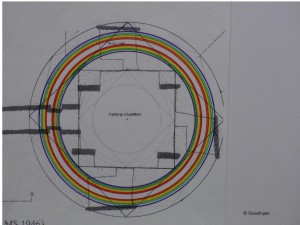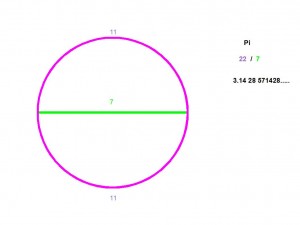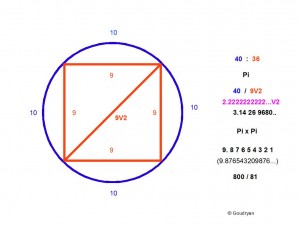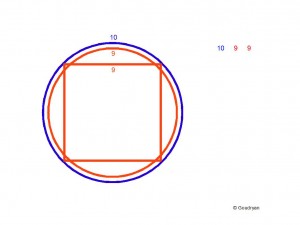The Rainbow Proportion
******* The Rainbow Proportion
Mathematical Gound plan Maeshowe
 Two inner circles form Rainbow Proportion
Two inner circles form Rainbow Proportion
It is true that this proportion cannot be strictly defined because of the vagueness of the rainbow edges and the inversion of the colours, also the double seems wider, but this is not about perfect math, but about a proportion that stone age people has observed as a matter of course, whenever they saw a double rainbow. What helps is that the primary rainbow has an angle of 42 degrees due to refraction in droplets, the double is given as around 52.4 degrees, but this is all vague, but 52.4 : 41 = 14 : 11. QED.
What it is? It is a huge confirmation of my intuition that the proportion is constant and part of two full circles.
Glad I’m right. I can again align this model with natural phenomena and their aesthetics and I am pleased to call this crucial part of the theorem:
the Rainbow Proportion, being 11 : 14.
It became clear to me that Stone Age humans may have been aware of this Rainbow Proportion within the Celestial Proportion (below, inner blue and red circles, outer blue celestial) which comprises the full transformation cycle, because they found it reflected in their mathematics of circles within squares within circles…and then squaring his circles… and finding fundamental ratios as 14 : 11. The proportion is not only conspicuously present in the design of Maeshowe, where it can be found in circular alignments of cell-corners (see below),
From above picture you can make measurements in mm, the centre spot is visible. Horizontal from the centre to the inner blue circle is 16mm on my pc, to the red circle is 20.364mm, this ratio is 20.364 : 16 = 1.2727 5 -> 14 / 11 = 1.2727 2… This means identical in our system, inner rainbow blue circle through cel-corners radius 11 and intermediate red circle through visible entrance cel corners=outer rainbow radius: 14, and in this geometry is the crucial ratio 11 : 14, another instant of the Celestial Proportion being the more universal mathematical name, including ratios 10:9 and 11:7, both) .
The outer two rings relate qua radius as red = 9 and blue = 10, which is in line with blue outer circle connecting the corners of the yellow square, peaking 1 unit out of the red ninth circle. So the quintessence of the proportions in the numbers 7, 9, 10, 11 is here at work and visible. When the outer blue ring is 10 circumference then the red ring has 9 as length, this is exactly the perimeter of the yellow big square. This the theorem ‘pur sang’.
Also in the Ring of Brodgar the ‘Rainbow’ occurs, where it is the relation of the stone circle proper and the outer perimeter of the ditch and it is even in the design of Stonehenge where it constitutes the earliest phase of the monument, that is, the ratio of the diameters of the Aubrey Holes circle and the platform edge, 11 : 14, (86.43 : 110.0 m, Burl), with the bank within, but without the ditch, this was about 3000 BC, some 5000 years ago. Stonehenge’s early phase is roughly contemporary with Orkney’s start(l)ing efflorescence.
This proportion even applies to an excavation drawing of two curb circles of cairn H at Carrowkeel (Ireland), again the double rainbow. Possibly a maternity clinic for the severe wintertime.
Megalithic chambers originally refuges
What I try to get across in all this is the idea that the chambers were in essence a domestic solution in times of severe cold and forbidding winds when people would freeze above ground and that they went ‘underground’ with an enormous mass of stone and earth on top of it all to preserve a livable temperature of at least 10*C, this was the reason of the long cumbersome entrance tunnels, to keep the outside cold and draught out.
In no way it would be freezing inside a well insulated chamber and warm clothes they probably had enough and the warmth of many human bodies in a small space did the trick, like the side cells for up to 10 people huddled together in the big chambers of the Maeshowe culture (Holm Papay), that always had the possibility of opening the roof for a draught of fresh air.
(It would be fantastic if some cineast would have the audacity to visualize a community of some 60 people living on the small island Holm of Papay while outside storms and freezing temperatures made continuous existence above ground impossible. Their housing did not suffice to keep them warm in extreme conditions. Underground was always the warmth of mother earth.
To be honest I do not know for how long a relatively large group of people can survive in such small spaces, with only ‘fresh’ air coming through the tunnel every time a new person went through although those of the Maeshowe culture were built with the possibility of opening the roof by removing slates. They were masters in corbelling with the flat slates. It may even be that due to the need of fresh air in the living space they had unconsciously created the first windows on the universe and got gripped by the movement of the stars through their window, how could they measure how long it took to traverse the diamond window by counting pulses with pebbles.
I hope that there will come a generation of students who are open to this emphasis on survival that I put on the function of the chambers and certainly some people, some families did not survive long spells of merciless weather. This is the reason that also bones of children (rare) have been found in chambers. I am confident that a generation of archaeologists and readers is here who know how to think and fantasize about climate change and it is not fun, but it is very necessary. Studying late Stone Age people going through a climate worsening, before during and after the 4th Millenium BCE. Compared to the severity and agony that characterized those deadly spells in the past, the happy go lucky approach of present day archaeologists in their reveries about ceremonies and rituals with human bones conducted by their pet-people’s priests, it’s simply pathetic and shows a deeply spoiled mindset by a life of comfortable conditions, and a total lack of empathy for their hard and short lives, as if they had idle time when putting enormous efforts in building places of common interest as refuges, (maternity) clinics, food storage, sheltering places for the stargazers at night and in the day (to sleep). Multi-purpose that is the key to the chambers where the use changed with the demands of the changing seasons and other conditions. Again, their initial primary function was survival, I have no doubt about that, because it makes most sense, given the climate change that occurred during the 3rd millennium, which I have coined Neolithic Ice Age. This was the period most megalithic chambers were built in Atlantic Europe. It stopped when the Trichterbecher culture came to an end. The cohesion of the communities fell apart when the climate improved and no more collective chambers were built, nor cramped gatherings endured with forbearance. The Beaker people were on the horizon, they would change a culture of collectivity forever in one of competition. They rode the horse and were belligerent.
The Rainbow proportion 11 : 14 forms part of the mathematics which underlies the designs of circles and squares that hold just this proportion as a matter of fact. Note its perfect ‘golden’ proportion as a ring 11: 14 ( as area it is 14^2 : 11^2 = 1.619 : 1, thus this is imperceptibly close to 1.618 : 1, the traditional golden section, difference 1/1000th. Golden section Phi is (1+sqrt(5)/2 = 1.618 0339… = (0.618 + 1) : 1 = 1.618 -> 1.618 : 0.618 = 2.618 = Phi^2 In this maths the golden section for sphere and torus is 1.62 : 1. Or more transparent as 162 : 100, which we can write as 2 x 9^2 : 10^2., the perennial ratio 10 : 9 in the background.
The question of whether the builders were aware of this correlation and subsequent connection between their mathematical model and the rainbow, is difficult to say, but they must have seen the rainbow as a full circle, a rare event, but with the profusion of rainbows in Orkney, Finstown! certainly very well possible; 3/4 circles can sometimes be seen in mountains.
I myself have been using the model for 11 years without noticing the analogy, until it struck. I am though inclined to think that they also were aware just because they had a far keener eye with regard to nature than I have and especially because, as in the Maeshowe plan (see picture, enlarge!) it is a feature in the design which is not visible at all, but only becomes apparent once one analyses the ratios and symmetries of the design and how they took pains to get all information in, but it is the essence of the mathematical theorem, so it can never be completely clear if they were aware of a connection, but its recurrence points in that direction. No doubt the use of the geometrical harmonies in building was seen as auspicious because it embodies numerical harmony and, as in this case, aesthetic celestial perfection. I have no doubt they regarded their insights in mathematics as deeply spiritual and even ‘divine revelations’.
To those who will maintain that people can build mathematically by intuition without knowing that they do, I would say that I am not un-sympathetic to that position when it would regard a single building and only few mathematical ratios would be involved; after all, I have proof that this mathematics is found elsewhere in nature and could be part of our innate knowledge of the divine, which mathematics is to a certain extent, think only of music and mathematical harmonies, but to find it again and again in distant, far apart places is at least remarkable.
When 4 major works are obviously in accord with the theorem and, as in the case of Stonehenge, most relevant data can be translated into the model, yes, are key numbers and ratios of the model and consistent with the data from Orkney, where sometimes even the same lengths as at Stonehenge appear, then to maintain that coincidence is the overbearing factor as an ‘explanation’ defies statistical odds. ‘Scientific scepsis’ can ruin valuable initiatives and is a scourge for any enthusiasm to tackle the climate crisis by the establishment.
The model’s perfect fit and meaning is irrefutable on the basis of the accepted scientific data, which are all provided by esteemed professionals. The only other option is a Divine Hand guiding them in the execution of the building and me in finding the mathematical key.
My data are sound, I don’t cook the books, but I was aware of ‘a’ Hand and in hindsight my personal life led me to incredible places, like Orkney, an archaeological treasure trove, it turned out, where I followed the starting excavations at the Ness from close by and where I lived for 9 years. It remains amazing how deeply involved I got with my new found mathematical model in exploring the intellect of this 5000 years old stone age culture.
To maintain against the odds that this is all only my analysis, and is a lucky coincidence or ‘intuition’ is far more ‘nonsensical’ than to consider they were aware of this rudimentary mathematics and indeed did use the same or similar units of length; the more so because, in fact, it is a basically simple and straightforward empirical model of natural number maths; the units of length were ready at hand anywhere, for being related to human bones, as I have shown (Bone Measures). Nothing is ceremonial here, everything is practical in origin.
That it seems all rather incredible at first, I can very well understand, I still hardly believe it myself, but this is ‘really’ because of my own prejudice about what I, and my culture, am inclined to think they could know, which though is culturally and personally defined; in the end I have become rather convinced, because you cannot deny mathematical and factual proof, certainly not when it is just because it does not suit your personal views or shakes the very foundations of your own belief system or worldview. This is science, this is mathematics, and mathematical proof, these are all solid ratios, this is not some kind of fancy fantasy. (the ratios are, in fact, just because they return again and again, independent of the similar units. The ratio 210 : 165 = identical to 14 : 11
The only other option is that they unconsciously worked by archetypical geometric truth or as I fancy by shamanic transfer.
For me there has emerged a strong additional argument in that: “if I can do it, without being a mathematician (or today maybe just because I am not) and by solely employing logical reasoning on ’empirical’ facts, the ‘natural number ratios’, that then they could do it. This is the more so because I found it all on my own, while they worked probably for hundreds of years with many and bright heads in a tradition of empirical mathematics, which this model in principle is.
So let me begin by showing why it is an empirical model, that is, a model based on experience with measurements, observations and logical reasoning.
To begin with, we know, for one thing, that Stone Age Man was capable of setting out proper circles, which is the majority of stone circles, we also know he was capable of proper spacing although this may be less evident in many circles, but it is evident at the Stones of Stenness (probably the first stone circle setting with up to over 5 m high flagstones ( maybe ever higher ones), and Stonehenge, of course, both object under investigation here. Paradoxically the perfect spacing of Stenness is accompanied by an imperfect circle (which may be two different half circles though, I lasered this on site with Keith Brown, also the apparent echo in the circle may have influenced the setting, with 4,5 stone standing an echo is still there), whereas at the Ring of Brodgar nearby, the opposite is the case, there the roundness of the circle is perfect but the spacing seems a mess (may be partly due to restoration activities), but like I have argued (in ‘Brodgar documents’), may be a very deliberate series of well-defined different spacings. But no echo, too big!
These two major stone circles, among the oldest around, could become the key to understanding neolithic times.
Here it should be noted outright that we cannot expect the kind of precision we associate with traditional mathematics given the means and the material our Stone Age people were dealing with; besides that they probably did not care so much about the precision of their execution as long as the mathematical principles, as expression of Heaven, as intention, were sound. Elsewhere I will point out how understandable it is that in the execution things went wrong.
At every stone circle the questions that came first were: how big are we going to make it and how many stones are we going to place, or the other way round. There are many instances of a certain number of stones with very different circle diameters and also the same diameters with very different numbers of stones. In many places the stones may have been spaced just on sight, without real calculation, but then still they had to have an idea where to place the stones before starting to dig their holes. I think that in general the bigger the stones, the more calculation went in beforehand. Here we are only interested in that category: big stones and/or big circles, major works.
At one moment in the early days of circle-setting the question must have arisen as to how the length of the radius or diameter related to the circumference, because of the question of the spacing of the stones in the circle. This is the question of Pi. I have ever read that mathematicians have given their verdict that the pyramid builders could not have known the approximation 22/7, because this would be too sophisticated a knowledge for ‘those people’. The Great Pyramid is about Pi and the Globe we live on. But since the verdict of the professionals it seems archaeologists don’t take anything seriously that is said in that direction anywhere by anyone, whatever the circumstantial evidence. This is outrageous.
The problem with mathematicians though may be that since high school they haven’t worked with compass and ruler, let alone that they have ever set out a (big) circle in the field.
 In the reality of the field, though, our circle setters would have found out quite soon that, after dividing their diameters in 3, in 4, in 5, in 6 equal lengths and comparing these lengths to the circumference of their circles, that one day they divided the diameter in 7 equal parts and, lo and behold, this length went exactly 11 times in the half circle, that is 22 times in the full circle circumference. Pi was born as 22 over 7. (=3.14 2857…;pi=3.14 1592…) This approximation is so precise that before there were calculators engineers used it in all their calculations on paper and their bridges still stand; it is within tolerance.
In the reality of the field, though, our circle setters would have found out quite soon that, after dividing their diameters in 3, in 4, in 5, in 6 equal lengths and comparing these lengths to the circumference of their circles, that one day they divided the diameter in 7 equal parts and, lo and behold, this length went exactly 11 times in the half circle, that is 22 times in the full circle circumference. Pi was born as 22 over 7. (=3.14 2857…;pi=3.14 1592…) This approximation is so precise that before there were calculators engineers used it in all their calculations on paper and their bridges still stand; it is within tolerance.
In this same way probably the ancient Egyptians found all their Pythagorean (3,4,5) and near-Pythagorean triangles in the field, just by trial and error, or by chance (20,21,29), not by mathematical reasoning! This is maths still as an empirical science!
I expect that once this complete model is understood and applied professionally it will cause a sea-change in science; but that will only show later on. What I am going to tell here is still harmless and fun. And remember, we are only dealing here with natural (whole) numbers and their ratios and all our approximations concern differences in thousandths only, and often much less, and always within resonance tolerance.
The following is the absolute crux of the mathematical model. It is this discovery which triggered 11 years of practically non-stop work on this model and brought me in regions I could not have dreamt of ever exploring when I started out, but I remember well the excited moments I found myself saying: ‘This is big’ .
How big it is I still have no way of judging; it still grows by the day, but I know it should not go lost again, please give it the attention it deserves.
It’s been here before
Just so as it is possible to put the ratio of half a circle and its diameter in the approximation 11 : 7, so it is possible to put the ratio of a quarter circle and the side of the inscribed square in the approximation 10 : 9
This results in a different value for Pi than 22/7. The new Pi is 20V2/9 or 2.22222…V2 (3.1426980495….) , which squared is 800/81 or 9.87654321 (9.8765432098765432098..), the model’s Pi-squared, which brings us back to the natural number ratios, and that is here, rational numbers (x over y = x/y). This model is not only an aesthetics of geometry it also produces remarkable numbers like 1.2345679012345679012… (no 8 indeed!, but with reason). These repeated sequences of numbers are called periods.
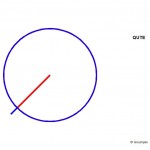 This new sqrt. value of Pi I have coined: ‘Qute’. It is cute.
This new sqrt. value of Pi I have coined: ‘Qute’. It is cute.
Its symbol is a mirrored Q; a blue circle with red radius which sticks out + 1/9 (or is it 1/10 ?) in blue, the stake is coming from the centre of the circle, which divides the stake in 9+1=10.
The next step is the big step. We square the circle by circumference, not by surface area, which is an essential difference, and thus we create a circle with circumference 36 (4×9), this means that the radii of the two circles with circumferences 40 (10) and 36 (9), also stand in the ratio 10 : 9.
This ratio holds for every circle squared by circumference (not area!), in our system: this square’s diagonal is equal to the diameter of its circumscribed circle, a circle that relates to the original circle as 10 : 9.
These two circles can be seen as part of a sequence of evenly spaced concentric circles, with radii : 1, 2, 3 ….. 9, 10, 11……..18,19, 20.
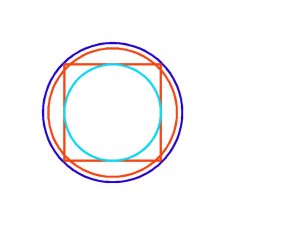 We know that the inscribed circle (turquoise) of a square always relates to the circumscribed circle (dark blue) in surface area as 1 : 2. So the dark blue circle is twice as big in area as the light blue circle. ( Here indeed: area)
We know that the inscribed circle (turquoise) of a square always relates to the circumscribed circle (dark blue) in surface area as 1 : 2. So the dark blue circle is twice as big in area as the light blue circle. ( Here indeed: area)
Remember, we deal here only with ratios, so we can attach our numbers to diagonals, diameters, radii, perimeters, areas, it makes no difference, as long as we are consequent and careful in our use.
Because the surface of the circle is π.r² we take the big blue circle to have a value of 10×10= 100, so the little circle being half, is 50, the red circle is then 81 (9×9) because the ninth square fits perfectly in the tenth circle. ( Pi is constant and irrelevant).
The red circle area thus relates to the small circle area as 81 : 50, which we can also write as 162:100 or as 1.62:1, the celestial proportion.
 We see here that the ratio 1.620 : 1 approximates the golden section (some say: divine proportion) or Phi, which is 1.618… : 1. (This is the Rainbow proportion by area). Because of the vagueness of the rainbow edges, it is just as well to claim it expresses the divine proportion by surface area. It is a vagueness that mathematicians may abhor, but that may then also be the reason none of them has ever come up with this perfect model of natural number approximations ( or was laughed away).
We see here that the ratio 1.620 : 1 approximates the golden section (some say: divine proportion) or Phi, which is 1.618… : 1. (This is the Rainbow proportion by area). Because of the vagueness of the rainbow edges, it is just as well to claim it expresses the divine proportion by surface area. It is a vagueness that mathematicians may abhor, but that may then also be the reason none of them has ever come up with this perfect model of natural number approximations ( or was laughed away).
When we want to know the ratios of the diameters, the radii or circumferences, we only have to extract the root of our surface values to get to our 1-dimensional values, because Pi is a constant in π.r² .
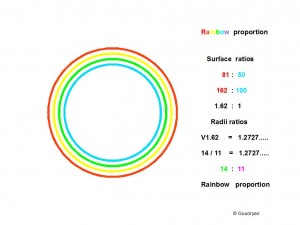 [This picture only symbolizes the double rainbow because it is technically not possible to do it properly in this computer program, the picture of Maeshowe (above) shows the double rainbow with inverse colours]
[This picture only symbolizes the double rainbow because it is technically not possible to do it properly in this computer program, the picture of Maeshowe (above) shows the double rainbow with inverse colours]
The square root of 1.62 is 1.2727 92… which is practically the same as the rational number 14/11, which is a period number 1.2727 272….
The difference is less than one/ten-thousandth! It is because of these extremely small differences that the model works, also in reality, which though is not of our concern here.
Important here is that we see that the 2-D area ratio 1.62 : 1 of the ‘Ten over Nine’-geometry can be substituted in the ‘Eleven over Seven’-geometry by the 1-D ratio 14 : 11, which is the Rainbow Proportion.
[[ (14/11)^2 = 1.6198 + 0.0002 = 1.62 , the Golden Mean of square-9 circle-10]]
QED
(Quod Erat Demonstrandum= what was to be demonstrated)
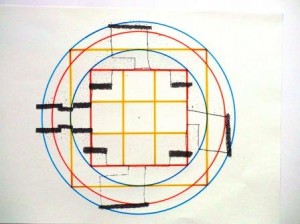
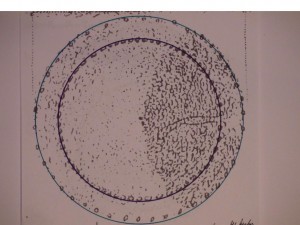 The diameter of this mount in the picture gives 49mm of the outer ring and 38.5 for the inner ring 49: 38.5 = 14 : 11
The diameter of this mount in the picture gives 49mm of the outer ring and 38.5 for the inner ring 49: 38.5 = 14 : 11